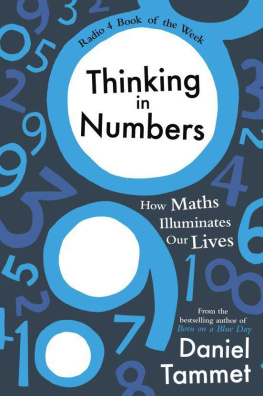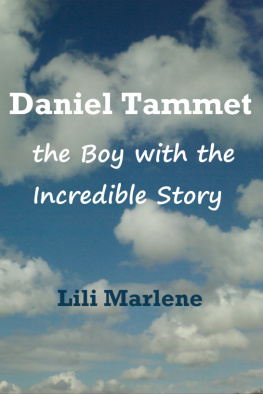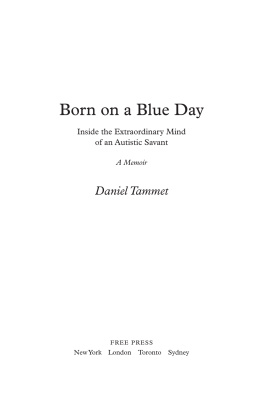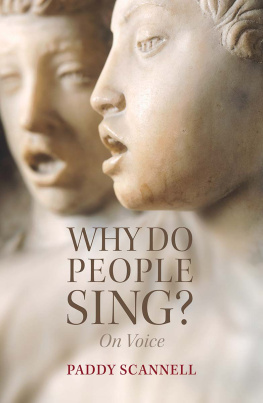Copyright 2017 by Daniel Tammet
Cover design by Kathleen Lynch
Cover illustration iStock
Author photograph by Jrme Tabet
Cover 2017 Hachette Book Group, Inc.
Hachette Book Group supports the right to free expression and the value of copyright. The purpose of copyright is to encourage writers and artists to produce the creative works that enrich our culture.
The scanning, uploading, and distribution of this book without permission is a theft of the authors intellectual property. If you would like permission to use material from the book (other than for review purposes), please contact permissions@hbgusa.com. Thank you for your support of the authors rights.
Little, Brown and Company
Hachette Book Group
1290 Avenue of the Americas, New York, NY 10104
littlebrown.com
twitter.com/littlebrown
facebook.com/littlebrownandcompany
First ebook edition: September 2017
Little, Brown and Company is a division of Hachette Book Group, Inc.
The Little, Brown name and logo are trademarks of Hachette Book Group, Inc.
English translation of The Farmer in the Wet Weather by Jnas
Hallgrmsson Richard Rigler, used with permission.
The following are reprinted by permission of Farrar, Straus and Giroux:
Excerpts from The Dream of Wearing Shorts Forever, The New Hieroglyphics, The Tin Clothes, The Tune on Your Mind, and The Warm Rain from New Selected Poems by Les Murray. Copyright 2007, 2012, 2014 by Les Murray.
Excerpt from Self-portrait from a Photograph from The Rabbiters Bounty by Les Murray. Copyright 1992 by Les Murray.
The publisher is not responsible for websites (or their content) that are not owned by the publisher.
The Hachette Speakers Bureau provides a wide range of authors for speaking events. To find out more, go to hachettespeakersbureau.com or call (866) 376-6591.
ISBN 978-0-316-35306-9
E3-20170727-JV-PC
In loving memory of my father
T hough English was the language of my parents, the language in which I was raised and schooled, I have never felt I belonged to it. I learned my mother tongue self-consciously, quite often confusedly, as if my mother were a foreigner to me, and her sole language my second. Always, in some corner of my child mind, a running translation was struggling to keep up. To say this word or that word in other words. To recompose the words of a sentence like so many pieces of a jigsaw puzzle. Years before doctors informed me of my high-functioning autism and the disconnect it causes between man and language, I had to figure out the world as best I could. I was a misfit. The world was made up of words. But I thought and felt and sometimes dreamed in a private language of numbers.
In my mind each number had a shapecomplete with color and texture and occasionally motion (a neurological phenomenon that scientists call synesthesia)and each shape a meaning. The meaning could be pictographic: eighty-nine, for instance, was dark blue, the color of a sky threatening storm; a beaded texture; and a fluttering, whirling, downward motion I understood as snow or, more broadly, winter. I remember, one winter, seeing snow fall outside my bedroom window for the first time. I was seven. The snow, pure white and thick-flaked, piled many inches high upon the ground, transforming the gray concrete of the neighborhood into a virgin, opalescent tundra. Snow, I gasped to my parents. Eighty-nine, I thought. The thought had hardly crossed my mind when I had another: nine hundred and seventy-nine. The view from my window resembled nine hundred and seventy-ninethe shimmer and beauty of eleven expanding, literally multiplying eighty-nines wintry swirl. I felt moved. My parents firstborn, I had been delivered at the end of a particularly cold and snowy January in 1979. The coincidence did not escape me. Everywhere I looked, it seemed, there were private meanings writ large.
Was it from that momentthe sudden sense that my meanings corresponded to the wider worldthat I first had the urge to communicate? Until that moment, I had never felt the need to open up to another person: not to my parents or siblings, let alone to any of the other children at my school. Now, suddenly, a feeling lived in me, for which I had neither name nor number (it was a little like the sadness of six, but different). I eventually learned the feeling was what we call loneliness. I had no friends. But how could I make myself understood to children from whom I felt so estranged? We spoke differently, thought differently. The other children hadnt the faintest idea (how could they?) that the relationship between eighty-nine and nine hundred and seventy-nine was like the r elationship between, say, diamond and adamant . And with what words might I have explained that eleven and forty-nine, my mental logograms, rhymed? A visual rhyme. I would have liked nothing better than to share with my classmates some of my poems made of numbers:
Sixty-one two two two two eleven
One hundred and thirty-one forty-nine
But I kept the poems to myself. The children at school intimidated me. In the playground every mouth was a shout, a snort, an insult. And the more the children roared, the more they laughed and joked in my direction, the less I dared approach them and attempt to strike up a conversation. Besides, I did not know what a conversation sounded like.
I renounced the idea of making friends. I had to admit that I wasnt ready. I retreated into myself, into the certainties of my numerical language. Alone with my thoughts in the relative calm and quiet of my bedroom, I dwelled on my number shapes, on their grammar. One hundred and eighty-one, a prime number, was a tall shiny symmetrical shape like a spoon. When I doubled itmodified its shape with that of two, which was a sort of doing numberit equated to a verb. So that three hundred and sixty-two had the meaning of to eat or to consume (more literally, to move a spoon). It was the mental picture that always announced that I was hungry. Other pictures that rose up in me could morph in a similar way, depending on the action they described and whether it was external or internal to me: thirteen (a rhythmic descending motion) if a raindrop on the windowpane caught my gaze, twenty-six if I tired and sensed myself drifting off to sleep.
My understanding of language as something visual carried over to my relationship with books once I became a library-goer and regularly tugged large, slender, brightly colored covers down from the shelves. Even before I could make out the words, I fell under the spell of The Adventures of Tintin . The boy with the blond quiff and his little sidekick dog, Snowy. Speech in bubbles; emotions in bold characters and exclamation marks; the story smoothly unfolding from picture to altered picture. Each frame was fit to pore over, so finely and minutely detailed: a mini-story in itself. Stories within stories, like numbers within numbers: I was mesmerized.
The same understanding, the same excitement, also helped me learn to read. This was my luck, since reading had not initially come easily to me. Except for the occasional word of comfort the night after a nightmare, my parents never read me bedtime stories, and because the antiepileptic medicine I was prescribed at a young age made me drowsy in class, I was never precocious. I have memories of constantly falling pages behind the other children, of intense bouts of concentration in order to catch up. My delight in the shapes of the words in my schoolbooks, their visual impression on me, made the difference. One of the books, I remember, contained an illustration of a black-cloaked witch, all sharp angles, astride her broom. To my six-year-old imagination, the letter






